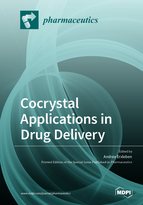Cocrystal Applications in Drug Delivery
A special issue of Pharmaceutics (ISSN 1999-4923). This special issue belongs to the section "Physical Pharmacy and Formulation".
Deadline for manuscript submissions: closed (30 April 2020) | Viewed by 38621
Special Issue Editor
Interests: pharmaceutical cocrystals; amorphous formulations; control of crystal size and habit
Special Issues, Collections and Topics in MDPI journals
Special Issue Information
Dear Colleagues,
Pharmaceutical cocrystals are multicomponent crystals in which at least one component is an active pharmaceutical ingredient. Cocrystallisation has long been recognised as a promising approach to modify the physicochemical properties of a drug without making chemical modifications to the drug molecule itself. The literature on cocrystals is constantly growing, and the small number of FDA approved cocrystals is increasing. Cocrystal formation is an attractive strategy to improve the bioavailability of a poorly soluble drug, i.e., to enhance the effectiveness of the drug becoming available at the target site. So far, many studies have focussed on the application of crystal engineering principles to rationally design cocrystals, the identification of supramolecular synthons, and the relationship between coformer selection and dissolution enhancement. On the other hand, there are several aspects of cocrystals that are understudied or still present significant challenges, such as the prediction of cocrystal formation, their formulation, large-scale production and process design. This Special Issue aims to highlight the potential of cocrystals in drug delivery, and we invite contributions on all aspects of the topic, both from fundamental research and practical applications.
Dr. Andrea Erxleben
Guest Editor
Manuscript Submission Information
Manuscripts should be submitted online at www.mdpi.com by registering and logging in to this website. Once you are registered, click here to go to the submission form. Manuscripts can be submitted until the deadline. All submissions that pass pre-check are peer-reviewed. Accepted papers will be published continuously in the journal (as soon as accepted) and will be listed together on the special issue website. Research articles, review articles as well as short communications are invited. For planned papers, a title and short abstract (about 100 words) can be sent to the Editorial Office for announcement on this website.
Submitted manuscripts should not have been published previously, nor be under consideration for publication elsewhere (except conference proceedings papers). All manuscripts are thoroughly refereed through a single-blind peer-review process. A guide for authors and other relevant information for submission of manuscripts is available on the Instructions for Authors page. Pharmaceutics is an international peer-reviewed open access monthly journal published by MDPI.
Please visit the Instructions for Authors page before submitting a manuscript. The Article Processing Charge (APC) for publication in this open access journal is 2900 CHF (Swiss Francs). Submitted papers should be well formatted and use good English. Authors may use MDPI's English editing service prior to publication or during author revisions.
Keywords
- crystal engineering
- multicomponent crystals
- prediction of cocrystal formation
- crystal structure–property relationships
- formulation
- dissolution behaviour
- in vitro properties
- in vivo properties
- large-scale preparation
- cocrystal polymorphism
Related Special Issue
- Cocrystal Applications in Drug Delivery (Volume II) in Pharmaceutics (6 articles)







